
Airbus A400M "Atlas" ..........................................................................Specifications

The first
A400M for the RAF was delivered in Novenber 2014. The "City of Bristol" is seen
as she appeared at
Hamburg Fuhlsbüttel airport in December 2014.
The Airbus A400M Atlas is a multi-national (Britain, France, Germany, Spain) four-engine turboprop military transport aircraft. It is built in Seville, Spain. It was designed by Airbus Military (merged in January 2014 to Airbus Defence and Space) as a tactical airlifter with strategic capabilities to replace older transport aircraft, such as the Transall C-160 and the Lockheed C-130 Hercules. Cargo capacity is expected to double over existing aircraft, both in payload and volume, and range is increased substantially as well. The cargo box is 17.71 m long excluding ramp, 4.00 m wide, and 3.85 m high (or 4.00 m aft of the wing).The A400M operates in many configurations including cargo transport, troop transport, and medical evacuation.The aircraft is intended for use on short, soft landing strips and for long-range, cargo transport flights. The aircraft is intended for use on short, soft landing strips and for long-range, cargo transport flights.
The aircraft features a fly-by-wire flight control system with sidestick controllers and flight envelope protection. Like other Airbus aircraft, the A400M has a full glass cockpit. Most of the aircraft systems are loosely based on those of the A380, but modified for the military mission. The hydraulic system has to two 3,000-psi channels powering the primary and secondary flight-control actuators, landing gear, wheel brakes, cargo door and optional hose-and-drogue refueling system. As with the A380, there is no third hydraulic system. Instead, there are two electrical systems; one is a set of dual-channel electrically powered hydraulic actuators, the other an array of electrically/hydraulically powered hybrid actuators. The dissimilar redundancy provides more protection against battle damage.
The A400M's wings are primarily carbon fibre reinforced plastic. The eight-bladed scimitar propeller is also made from a woven composite material. The aircraft is powered by four Europrop TP400-D6 engines rated at 8,250 kW (11,000 hp) each.The TP400-D6 engine is to be the most powerful turboprop engine in the West to enter operational use.
The pair of propellers on each wing of the A400M turn in opposite directions, with the tips of the propellers advancing from above towards the midpoint between the two engines. This is in contrast to the overwhelming majority of multi-engine propeller driven aircraft where all propellers turn in the same direction. The counter-rotation is achieved by the use of a gearbox fitted to two of the engines, and only the propeller turns the opposite direction; all four engines are identical and turn in the same direction. This eliminates the need to have two different "handed" engines on stock for the same aircraft, simplifying maintenance and supply costs. This configuration, dubbed DBE (Down Between Engines), allows the aircraft to produce more lift and lessens the torque and prop wash on each wing. It also reduces yaw in the event of an outboard engine failure.
A forward-looking infrared enhanced vision system (EVS) camera provides an enhanced terrain view in low-visibility conditions. The EVS imagery is displayed on the HUD for low altitude flying, demonstrating its value for flying tactical missions at night or in clouds. EADS and Thales provides the new Multi-Colour Infrared Alerting Sensor (MIRAS) missile warning sensor for the A400M.
The A400M has a removable refuelling probe mounted above the cockpit to allow the aircraft to receive fuel from drogue-equipped tankers. Optionally, the receiving probe can be replaced with a fuselage mounted UARRSI receptacle for receiving fuel from boom equipped tankers. The aircraft can also act as a tanker when fitted with two wing mounted hose and drogue under-wing refuelling pods or a centre-line Hose and Drum unit.
The A400M features deployable baffles in front of the rear side doors, intended to give paratroops time to get clear of the aircraft before they are hit by the slipstream.
Customers so far include Britain, Germany, France, Spain, Turkey, Belgium, Luxembourg, and Malaysia. The South African Government had also an order for 8 aircraft but cancelled early on in 2009 due to ever rising unit costs ! To date 12 A400Ms have been delivered to five customers: the French Air Force (6), the UK Royal Air Force (2), the Turkish Air Force (2), the German Air Force (1) and the Royal Malaysian Air Force (1).
The aircraft first flew in Seville 11th December 2009 with the first production aircraft going to France in 2013. The program has been plagued with delays and set backs all along, most importantly concerning the powerplants. In 2009 the aircraft was reportedly overweight by 12 tons and achievment of the critical performance requirement, the ability to airlift 32 tons, was endangered, apparantely at that time the aircraft could only lift 29 tons, which is insufficient to carry a modern armored infantry fighting vehicle, like the Puma. On 9 May 2015, an A400M crashed in Seville on its first production test flight.The German, Malaysian, Turkish and UK air forces suspended flights of its aircraft while the accident was investigated. Airbus initially focused on whether the crash of aircraft serial number MSN023 was caused by new management software for the engine-fuel supply, designed to trim the fuel tanks to permit the aircraft to fly certain military maneuvers, and issued an update instructing operators to inspect all Engine Control Units (ECUs).
The first A400M to be delivered ti the RAF was delivered in November 2014. The aircraft, "City of Bristol" is shown as she appeared